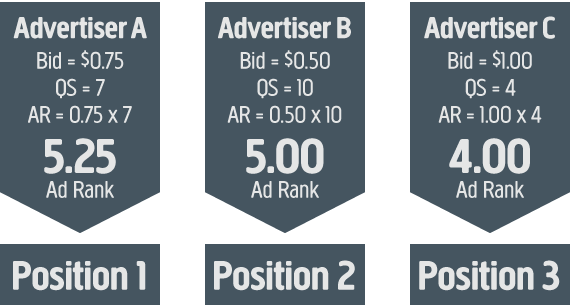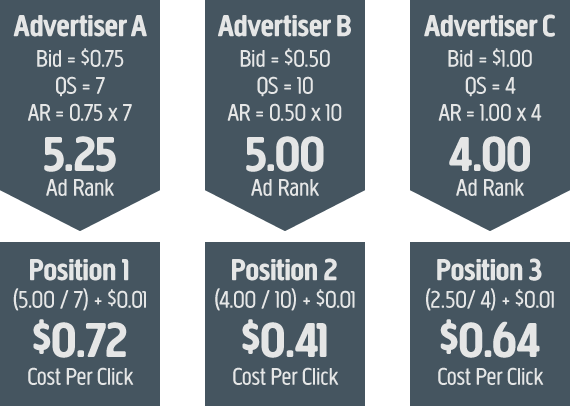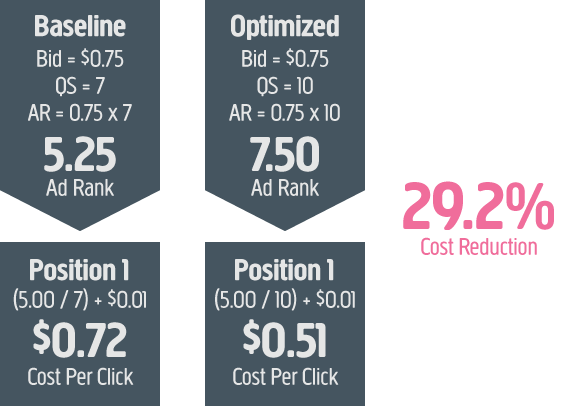Before Google implemented quality scores for search advertising, Google searches were overrun with irrelevant ads that linked to sites with little content. Any marketer could bid on nearly any term and show in the paid results and placement was simple: higher CPC bids equalled higher ad rank. This created an overall poor search experience for the user. Google eventually improved ad quality by being the first search engine to assign quality scores, which attempt to measure ad relevance.
Instead of the highest paid search position being awarded to the highest CPC bidder, Google’s new Ad Rank (AR) is based on both CPC bid and quality score (QS):
AR = Bid x QS
The bid is set by the advertiser, however the quality score is assigned by Google. Although there are a myriad of factors that impact quality score, the four that advertisers can easily control are:
- Relevance of the keyword to the ad copy
- Relevance of the the keyword to the landing page copy
- Relevance of the ad copy to the landing page copy
- Historical click-through rate (Google assumes that if your ad is clicked frequently for a particular search query, the user sees it as relevant)
Although this means significantly more work for the online marketer, it results in a major advantage for the marketer that is willing to do the work. Here is an example of three different advertisers bidding on the same search term:

As you can see, the highest bidder (Advertiser C) is going to end up in the first paid search position. Advertiser A’s ad will show first and with a bid that is 25% lower than Advertiser C’s bid.
How much will each advertiser actually pay? The actual cost of each click is determined by the following formula:
Actual Cost = ( Ad Rank of the Position Below / Quality Score of Your Ad ) + $0.01
Here is what each of the advertisers above will actually pay per click:

Although Advertiser A has the highest Cost-Per-Click to be in position #1 in this case, the really interesting observation is the relationship between Advertisers B and C. Advertiser B shows higher in the search results that Advertiser C, yet Advertiser B will pay less than half of what Advertiser C will par per click. This is all due to the fact that Advertiser B has a significantly higher quality score.
Let’s see what would happen if Advertiser A raised his quality score to 10:

If Advertiser A raised his Google Adwords quality score to 10, he would realize a reduction in cost per click of nearly 30%. When you are dealing with budgets in the millions of dollars annually, that could make an enormous impact on the bottom line.
So now you know that higher quality scores lead to better rankings and lower advertising costs. Here are the simple things you can do right now to improve your Google Adwords quality scores:
- Reorganize your campaigns into small, tightly targeted ad groups for improved relevance
- Write targeted ads that include your target keyword in the title, body, and URL (if possible)
- Utilize multiple landing pages. The landing page should have a significant density of your target keywords for a particular ad group. If all of your ads point to your home page, you are probably doing it wrong.
- Include a clear call to action in your ad copy. This improves Click-Thru-Rate which improves quality scores over time.
Improved Relevance
= More Clicks at Lower CPC
= More Conversions at Lower CPA
= Higher ROI on Your Ad Budget.
Now get to work…
Credit: VURR

